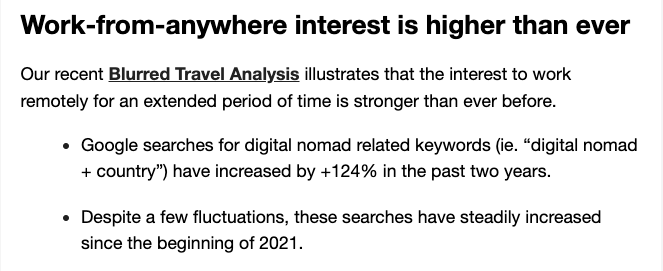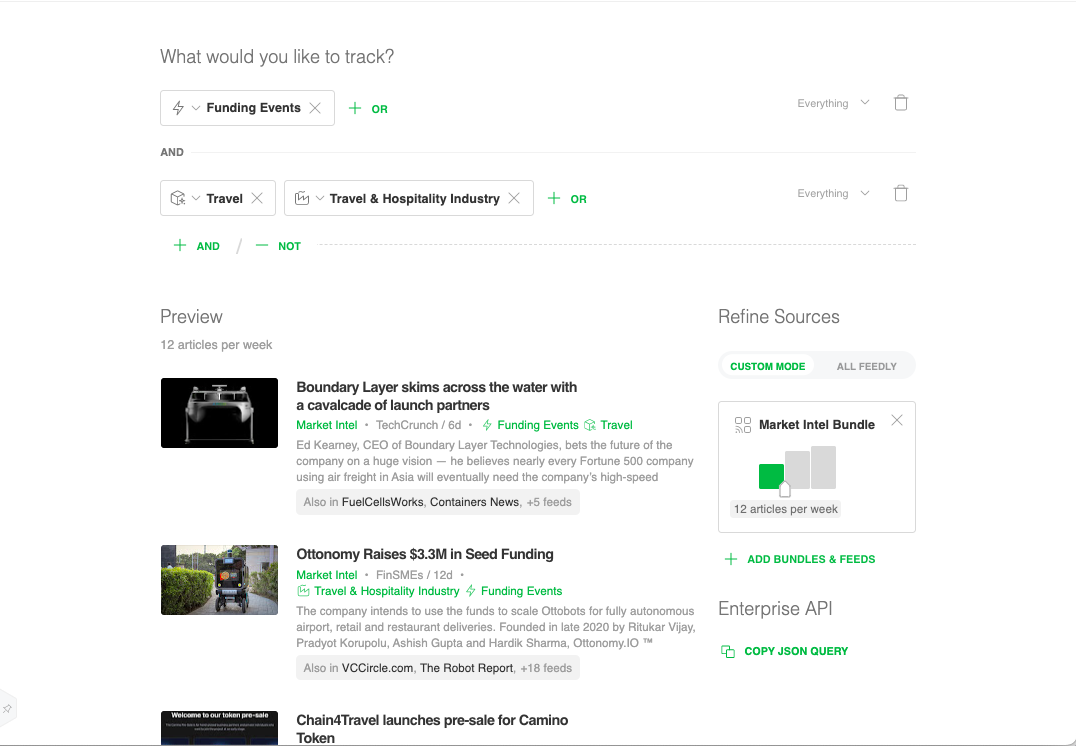
THE SOLUTION
Using Feedly AI to research and define the future of their market: Travel and Mobility Tech
LIH was able to go one step further than just professionalizing their intelligence-gathering: They have defined their arena at the intersection of travel, mobility, and tech (TNMT).
TNMT brings together traditionally-siloed interests that cover the entire ecosystem of products and services around the travel experience, from accommodation to space travel.
By adopting Feedly AI to discover and research new market opportunities, LIH gathers and synthesizes intelligence that covers this entire category. They can shape, test, and validate hypotheses that will define the future of travel.
“It’s strategically powerful to be able to define our own category and be the leaders in what we’re doing. And that’s where Feedly comes in. It allows us to create our own definitions and categories, beyond standard industry definitions. We can build everything around this TNMT model and see what we find there.”
“Blurred Travel” and other future trends
When Tino and his team identify a new “fuzzy concept” or broader trend that they want to research and define, they set up a new Feedly Board on the topic and add relevant articles from other boards. From there, one of their analysts will define which keywords to track. They will build an AI Feed and gradually refine it, adding models and muting terms to filter out the noise.
For example, LIH has coined the model of “Blurred Travel,” a shift they’re seeing as we emerge from the COVID-19 pandemic, where business and leisure travel are increasingly merging. “It’s really hard to search for a term if you’re the one coining it,” Tino says. “To validate our hypotheses, we try to put different AI models together and look at what is coming through Feedly to see what is happening out there.”

Tracking innovation via venture capital investments
LIH also uses AI Feeds in Feedly to track venture capital investments in travel and mobility tech in order to predict how the industry will evolve. “Venture capital investments are one of our key metrics to determine innovation patterns,” Tino explains. “We want to know where smart people are putting a lot of money, and to understand why it’s happening. It’s a really good proxy indicator for us.” LIH publishes the only regular report with in-depth research on this topic.
“Venture capital investments are one of our key metrics to determine innovation patterns. We want to know where smart people are putting a lot of money, and to understand why it’s happening. It’s a really good proxy indicator for us”
They also track over 3,000 startups to keep an eye out for investment and partnership opportunities with startups in related industries, like sustainable fuel, air taxis, and the creator economy.

Integrating Feedly into their processes and tech stack
Part of what makes Feedly so effective for LIH is the way the team has been able to deeply integrate Feedly into their processes and the rest of their tech stack.
Tino and the LIH team use AI Models, a collection of machine learning models that continuously read millions of articles to analyze and tag key concepts in real-time. For example, they employ the Partnerships and Funding AI Models to keep a close eye on partnerships that other airlines are forming with startups. This gives them a clearer sense of the direction their industry is heading and what other companies are prioritizing.
LIH also uses Feedly as the jumping off point for kickstart new projects: Employees combine AI Models in AI Feeds, which track and find relevant content continuously. Through the AI Feeds they’ve set up, the team finds useful content and regularly adds it to Boards.
When a new project starts, employees search those Boards to see what’s been gathered on the topic and what information is already out there, curated by their team in Feedly. They’ll then create a new Board and connect it to the Slack channel for that project to keep all relevant research in one place.
Company onboarding at LIH even includes a Feedly tutorial. “That’s how deeply we want Feedly to be embedded in our processes“ says Tino.














